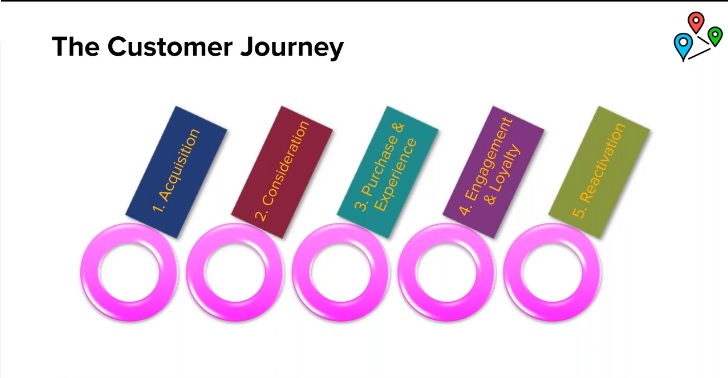In this post I’m taking a long hard look at Kate Barrett’s lecture “Understanding the eCommerce Customer Journey”.
Nothing new under the sun
As Barrett immediately points out, customer segmentation and targeting are nothing new in the world of marketing. Things like customer records, quick orders, and home deliveries have been valuable tools for any competitive business since always.
In my opinion, we can draw an interesting question from this observation. These days people have somewhat of a grey line when it comes to personal information. We have repeatedly heard the demand for retails to cease their information gathering, in the name of personal privacy. However, Barrett makes the case that customers giving out their personal information is not a new phenomenon. So where does this newfound interest towards personal privacy that, exists or doesn’t exist depending on platform stem from? I believe it comes from automation and the feeling of choice itself, instead of the privacy itself. The customer doesn’t really care about its (yes, it’s “it” and not a person) privacy, they care about the illusion of choice. This works as a good gateway to our next point!
Creepy crawlies of e-commerce

Creeping is a phenomenon made popular in marketing by the store chain Target. Target famously started to segment its customers, based on their search interests and targeting advertisements based on these interests. When left solely to the hands of the algorithms this tactic quickly backfired, as Target advertised pregnancy products to a teen, who had not yet opened up to its parents. This rather infamous story has become somewhat of a poster child for unsustainable marketing practices.
So what can we learn from Target’s example?
Barrett points out how there exists a fine line between customer segment targeted marketing and what is called “creepy”. “Creepy” is what happens when you blindly just target and in doing so forget the human element from the middle. The system worked too well for the customers and the result was a disaster. This is important to remember when utilizing AIs to help your marketing. The computer is too good at its job and what people need is “humane mistakes”. Barrett continues her example by pointing out that after the system started to also offer products that were “wrong” for that particular customer, the creepiness disappeared. The example used here is wine classes offered to a pregnant woman. Obviously wine class would be an obsolete object to someone carrying a child, but it does wonder into tricking your customer into not noticing the same algorithm still playing its tricks.
This faking a human mistake, hiding your data mining and automatization and customer manipulation of course may sound somewhat unethical to some readers. I however can speak from experience when I say, that all this becomes much easier if you stop seeing your customers as humans and more as dumb animals.
Five steps of customer engagement
Barrett identifies five steps in getting your customer roped in with your business.

Acquisition
This is the first step, the point where the original magic happens! The acquisition is the key moment when you set your sights on a new mark. At this moment the customer is expected to learn about your brand. The point here is to gather as much personal data as possible and get the customer to sign up for your spam…newsletter. There are some excellent tools to help you.
The first trick that Barrett gives is to ask for customer consent, but in a carefully worded question where you ask if the customer “does not wish to receive your newsletter”. In this wording, you can safely have the answer “no” be pre-selected for your customer. Most customers won’t read the question and blindly just go with the “no” option. Then you can flush their e-mail accounts with your newsletters. It might also help to make the resigning process to be as arduous as possible.
Consideration
So you got them into your hook, now what? You make them do that first purchase of course! After this moment you are a reliable seller to them and it’s easier to cram more junk down their throats. Barrett gives some good tips like first-time customer discounts or product bundles.
I too think that bundles are a great way to go. You can get a handful of products together and advertise the percentage that they will save. “With this bundle 60% off, 70%” you can boast. The percentage is easy to achieve, just make sure the bundle includes some cheaply made Chinese knick-knack that has been way over-priced in your store. Sneak into your baking bundle a fridge magnet with an asking price of 50$? That’s easy -40% of bundled products right there! Most customers are too lazy to check out the individual item prices anyway.
Purchase and experience
Here you groom the first-time customer into becoming an advocate for your brand. There are no easy workarounds here, which makes this step kind of a nuisance. This however is important, as it’s this way you gain those sweet, sweet advocates. Here Barrett suggests using marketing emails that recommend similar products the customer has already bought or instructional videos. Like said, kind of a nuisance.
Engagement and loyalty
To turn your customer into true faithful you have to pat them in the back now and then. Birthday e-mails and discounts are an easy way to do this. At the same time sneaky marketing you can also slip in a small questionnaire that gathers some more personal data from your customer.
Reactivation
In the case that you somehow lose a customer it’s vital to reel them pack in. In here you have to be somewhat innovative or then just offer crazy good discounts. Whatever it’s that you do, do it fast and keep taps on your customers. A couple of months of not buying and the alarm bells should ring. One of the golden rules of marketing is that it’s always ten times more costly to gain a new customer than it’s to keep a hold of an existing one.
That’s Kate Barrett’s lecture summarized! Now go out there and get that dollar!
